Supporting collaborative learning

Collaborative learning has been called a success story. This is because research has established that, when designed adequately, collaborative learning can have a positive impact on for instance, students’ exam performance, achievement, and skill development Education Endowment Foundation (n.d.). Collaborative learning approaches. https://educationendowmentfoundation.org.uk/education-evidence/teaching-learning-toolkit/collaborative-learning-approaches Kyndt, E., Raes, E., Lismont, B., Timmers, F., Cascallar, E., & Dochy, F. (2013). A meta-analysis of the effects of face-to-face cooperative learning. Do recent studies falsify or verify earlier findings? Educational Research Review, 10, 133-149. Additionally, it has been demonstrated that collaborative learning can be used to increase students’ openness to diversity and development of intercultural competences. Cabrera, A. F., Crissman, J. L., Bernal, E. M., Nora, A., Terenzini, P. T., & Pascarella, E. T. (2002). Collaborative learning: Its impact on college students' development and diversity. Journal of College Student Development, 43(1), 20–34. De Hei, M., Tabacaru, C., Sjoer, E., Rippe, R., and Walenkamp, J. 2020. Developing Intercultural Competence through Collaborative Learning in Inter-national Higher Education. Journal of Studies in International Education, 24(2), 190-211. In general, collaborative learning is defined as situations during which students work together on a task or problem with a clear common goal or end product.
There are typically two reasons to apply collaborative learning in university teaching.
- First, collaborative learning is a great way to promote all students’ engagement. With a carefully designed group assignment, you can ensure that many students will be engaged learners and that they will engage in valuable discussions with their peers.
- Second, collaborative learning also helps students to practice important communication and collaboration skills, and thus can help students to function in a society that requires them to engage with people with diverse backgrounds (see also Topic Including different viewpoints and perspectives).
Tools
To make sure the collaboration goes smoothly and all students learn as much as possible, teachers may pay attention to the following things:
- Make heterogeneous groups of approximately 4 students, considering differences in prior knowledge, disciplinary knowledge and backgrounds.
- Make sure the assignment is sufficiently complex to make sure students have to work together to achieve the assignment. If the task can be carried out by only one group member, it is not complex or demanding enough. Kirschner, F., Paas, F., & Kirschner, P. A. (2009). Individual and group-based learning from complex cognitive tasks: Effects on retention and transfer efficiency. Computers in Human Behavior, 25, 306-314.
- Make sure the group task stimulates individual accountability. This can be assured when each group members’ contribution to the group task is visible through, for instance, giving students different roles or asking students to write a short individual reflection on their contribution to the group product and process.
- Create task interdependence: By splitting a large, complex task into multiple interdependent subtasks, students require the input of their group members to complete their own task. Aronson, E., & Patnoe S. (1978). The Jigsaw Classroom (p. 197). Beverly Hills, CA: Sage Publications. The Jigsaw strategy can be a useful strategy to accomplish this (see the website of Erasmus University Rotterdam for more information).
- Setting ground rules for collaboration and supervision of students’ discussions: To ensure collaborative discussions that involve all group members, it is important to establish ground rules for collaboration with students. This can be done together with the students enrolled in the course. Wegerif, R., Mercer, N., & Dawes, L. (1999). From social interaction to individual reasoning: An empirical investigation of a possible socio-cultural model of cognitive development. Learning and Instruction, 9, 493-516 It is also important that teachers supervise their students’ collaborative discussions. For example, by giving feedback about the way students are communicating, asking critical questions about the way students are working together and by giving advice. See also Topic 1: Including different viewpoints and perspectives and creating a safe learning environment.
Want to know more?
| https://youlearn.ou.nl/web/bison | This electronic handbook gives advice for teachers who want to get started with online collaborative learning. |
| https://www.teaching.unsw.edu.au/assessing-group-work | Video by University of New South Wales about assessment during collaborative learning |
| https://www.teaching.unsw.edu.au/group-work-when-groups-first-meet | Tips by University of New South Wales to help groups to become effective groups. |
